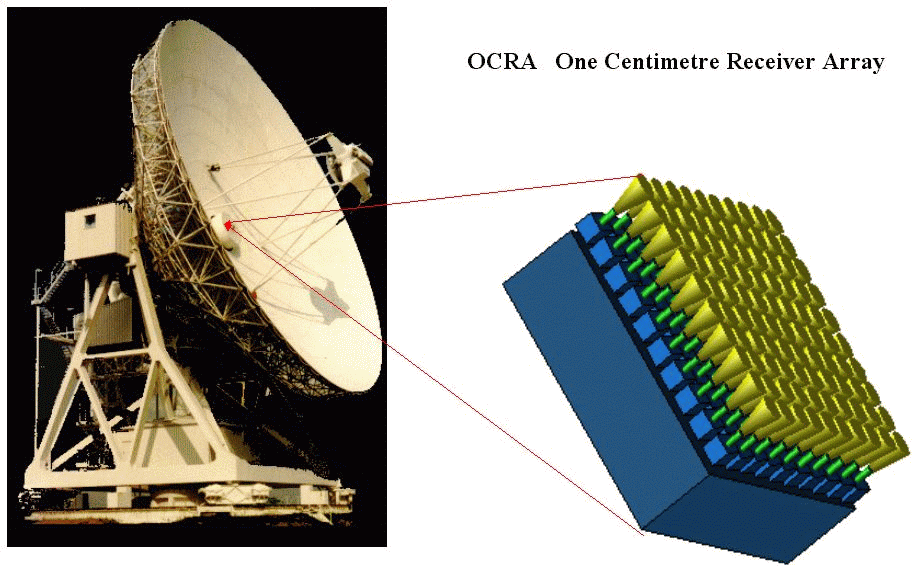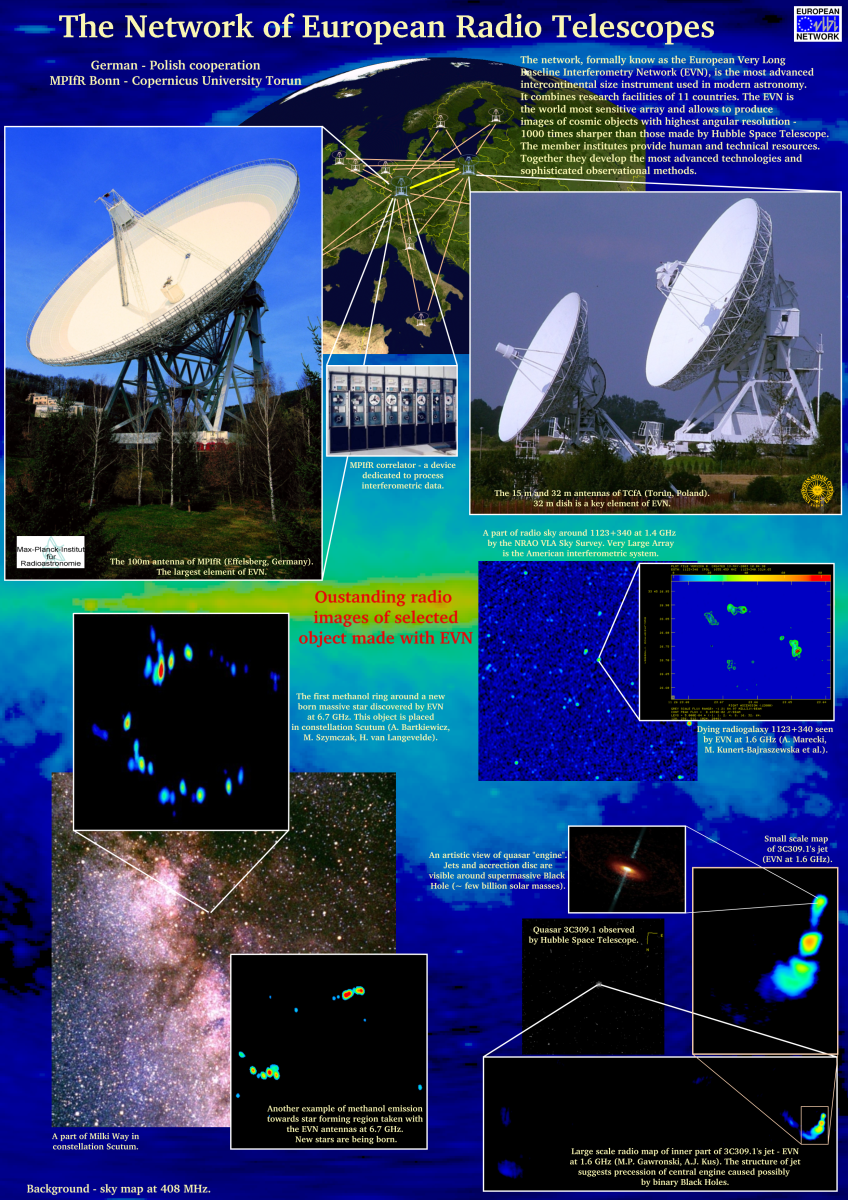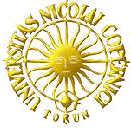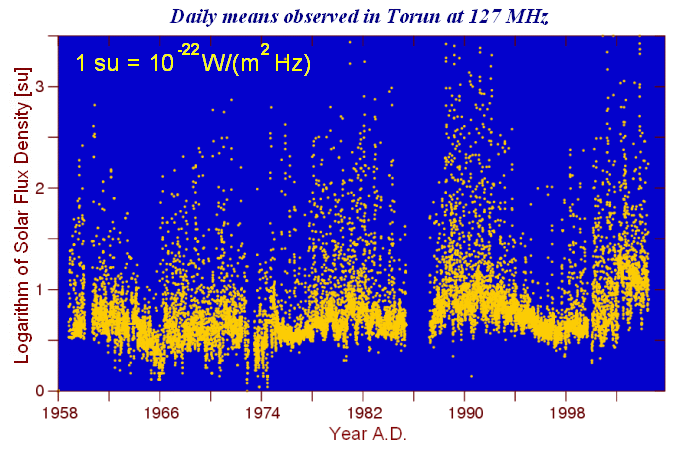Talk presented at the Physics Department
of the University of Rome "La Sapienza" on April 6, 2006
Radio Astronomy
at Torun
dr Kazimierz Borkowski
Centre for Astronomy, N.Copernicus University, Torun, Poland
n Introduction
Torun, the University and
the Observatory
Radio astronomy
Our equipment
n Current projects and research areas
Very Long Baseline Interferometry (VLBI)
Spectral observations
Solar observations
Pulsars
Polarimetry
OCRA project
Cosmology
80-100 m telescope project
Introduction

|
Toruñ
population: ~210 000 (on decline)
Nicolaus Copernicus University
workers: 4100 (2000 scientists)
students: 42000 (externals: half)
faculties: 14
specialties: >100
Faculty of Physics Astronomy and Informatics
Torun Centre for Astronomy (TCfA)
Department of Radio Astronomy
workers: 25
(7 scientists)
PhD students: 6
|
|
View of the TRAO from 32-m telescope (click to get full resolution)

l Our equipment
32 m radio telescope (RT32; in use since 1994)
15 m radio telescope
23 m interferometer (127 MHz)
VLBA terminal (with tape recorder)
VLBI disk recorder Mark5A (1 Gb/s)
hydrogen maser (stability: 10-15)
GPS receiver
radio astronomy receivers (1, 1.3-1.8, 5, 6, 12, 30 GHz)
16384-channel digital spectrograph
pulsar machine (64-channels, 3 MHz each)

l Solar observations
Frequency: 127 MHz
Time range: 1958 - present
Instrument: 10 l interferometer; Dicke type receiver
Results: regular monthly publications
|
World longest series of observations at metre wavelengths
|
l Pulsar observations
Frequency: L-band (l = 21 cm; mostly)
Instrument: RT32 +
pulsar machine
Type: long-term timing of some 50 pulsars

l Spectral observations
Frequency: L-band (18 cm) & M-band (5 cm)
Instruments: RT32 + 16384-channel
autocorrelator
and also VLBI (EVN) + Merlin, Nancay and Bonn
Science: maser lines of hydroxyl (OH)
and methanol (CH3OH)

Examples of methanol line sources
l OCRA - array of 1 cm receivers (with JBO)
Frequency: 30 GHz (1 cm)
Instruments: RT32 +
OCRA-p/OCRA-f
Aim: All sky survey


OCRA-p (currently in use)

l VLBI
Method, results and accessibility:
Independent simultaneous observations
Recording on magnetic tapes or disks (Mark5A)
Disks assembled into 8-packs: up to 3.2 TByte capacity
Signal: Gaussian with 0 mean
Nyquist sampling at 2 Df (rates up to 1 Gsamples/s)
1- or 2-bit samples
All stations data combined with a dedicated correlator
Proposals accepted according to referees ranking
Result: maps or reduced data for the PI only
After a year the results are released for all interested
Science: extragalactic sources, spectral lines (stars),
supernovae and pulsars (occasionally)
Observations: three 4-week sessions a year
Frequencies/bands: L (21, 18 cm), C (6 cm) & M (5 cm)
Instruments: EVN + MERLIN + VLBA + Halca and
correlators (JIVE, Bonn, Socorro, Mitaka and Penticton)
EVN
(European VLBI Network)

Low-resolution copy of a poster recently prepared in the TCfA
that presents our involvement in EVN activities

Courtesy of TCfA
Example map of a quasar
obtained from observations with the 8-m space antenna (VSOP) plus Effelsberg, Noto, Torun and Hartebeesthoek ground radio telescopes

e-VLBI - the future of VLBI
All telescopes connected by optical fibres
Transmission speeds up to 10 Gbits/s (bandwidth up to 5 GHz!)
On-line correlation and immediate results (maps)

The spectrum of IRC+10420 at 1612 MHz as observed during the EVN e-VLBI observations. The total velocity width of the emission shows that the shell is expanding at about 40 km/s
|
20-hour long observations, performed in
September 2004 using the EVN, involved radio telescopes in the UK, Sweden, the Netherlands, Poland and Puerto Rico. The maximum separation of the antennas was 8200 km, giving a resolution of at least 20 milliarcseconds (mas); this is about 5 times better than the Hubble Space Telescope.
Each telescope was connected to its country's National Research and Education Network (NREN), and the data routed at 32 Mbits/second per telescope through GÉANT, the pan-European research network, to SURFnet, the Dutch network.
|
Present e-VLBI status
Introduced: Europe (EVN); tests: USA, Japan, Australia
1 Gbit/second connections from:
Onsala, Jodrell Bank, Cambdridge, Westerbork, Medicina and Torun.
Practically usable speed: 128 Mb/s
Tomorrow (Friday): Test of transfers (Medicina, Torun, Jodrell Bank)
20 April: 24-hour science experiment
l 80-100 m telescope project
Type: Offset paraboloid, altitude-only steerable
Frequency: 5 - 22 GHz
Stage: feasibility study















